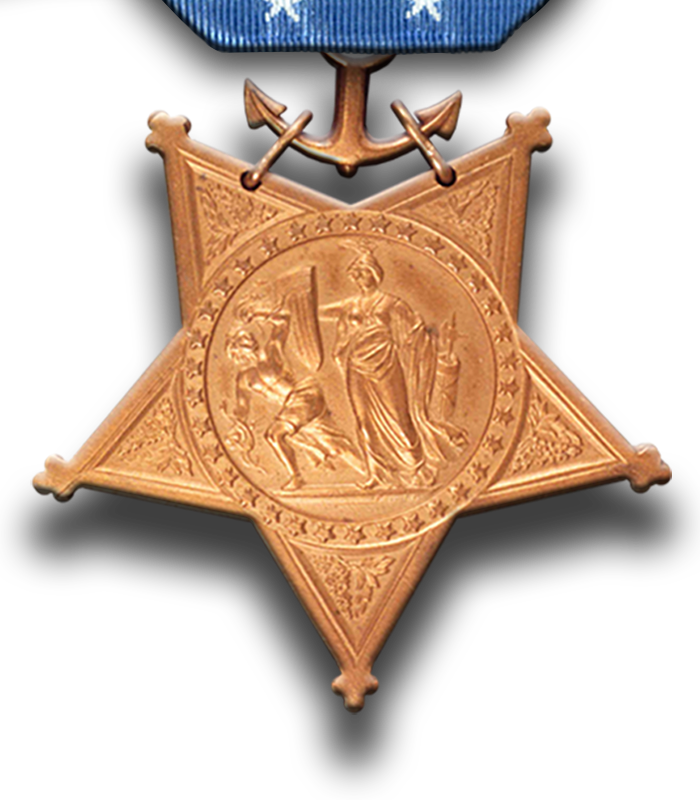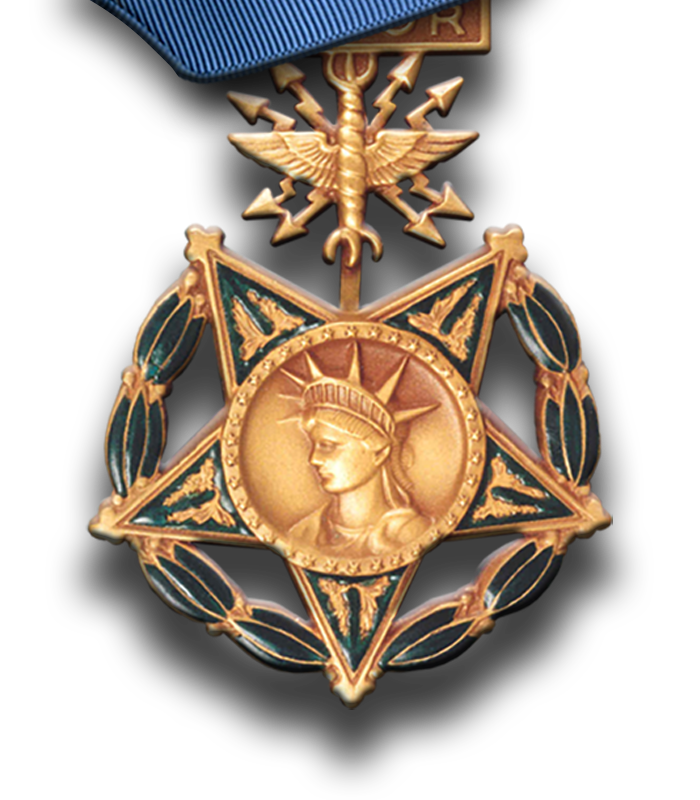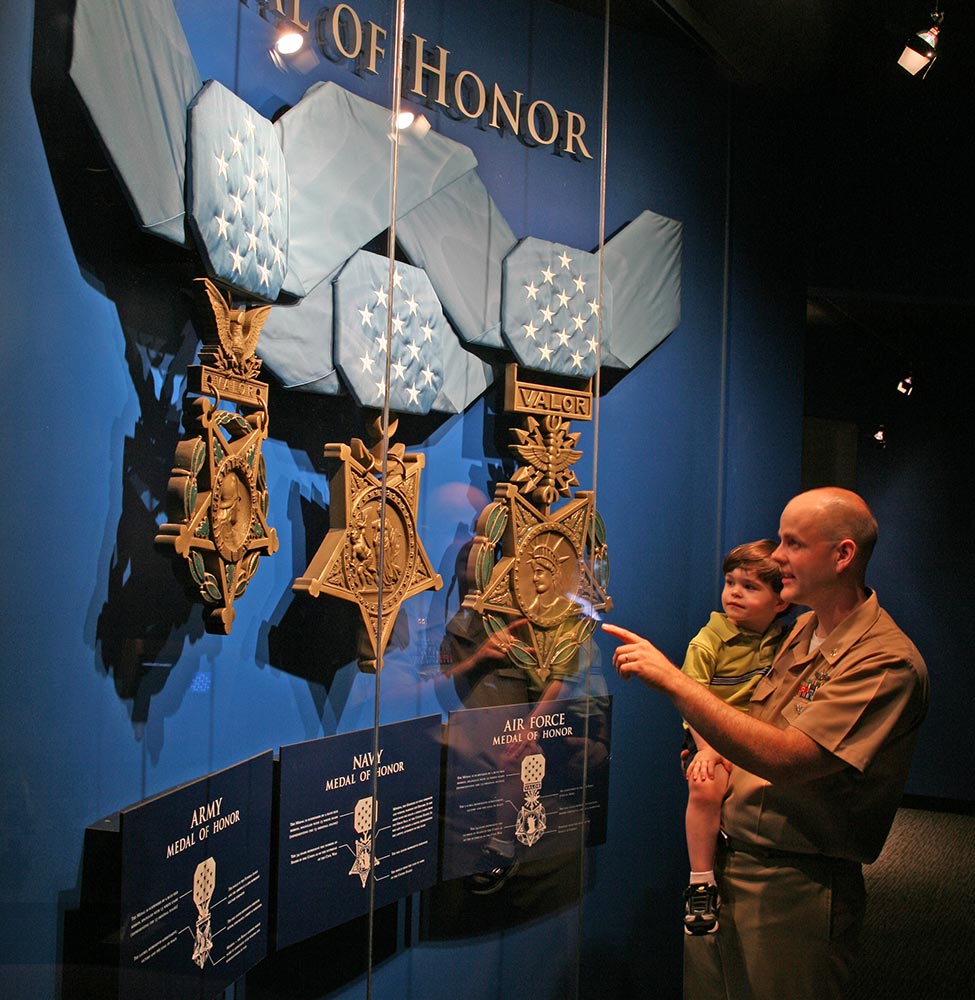The Medal of Honor

The Medal
The Medal of Honor was born during the Civil War as a way of honoring those who distinguished themselves in the line of duty.
Each Medal was thoughtfully designed to reflect the values of its recipients. Steeped with symbolism, the Medal has become a historic symbol of our nation’s bravest, those that “…distinguishes himself conspicuously by gallantry and intrepidity at the risk of his life above and beyond the call of duty.”

Laurel Wreath: The wreath of laurel leaves, a symbol of victory, was added in 1904.
Oak Clusters: Dark green oak clusters located in each of the star’s five points represent strength.
United States of America: The words “United States of America” surround the central engraving.
Minerva: A simple profile of Minerva, the Helmeted Goddess of Wisdom and War, rests in the center of the medal.

Laurel & Oak Leaves: Clusters of laurel and oak leaves located on each of the star’s five points represent victory and strength.
34 Stars: The 34 stars encircling the insignia are equal to the number of stars on the U.S. Flag in 1862. Each star represents a state, from both Union and Confederate states.
Minerva: The Roman Goddess of Wisdom and War, Minerva is depicted warding off a man clutching snakes in his hand, meant to represent discord. The shield in Minerva’s right hand is representative of the Union of our States, while the bundle of rods and axe blade in her left is symbolic of authority. The owl perched on her helmet is a symbol of wisdom.

Lady Liberty: The Statue of Liberty is centered in the Air Force design. In addition to standing for Liberty, she is derived from the imagery of Queen Semiramis of Babylon who was famed for her beauty, strength, and wisdom.
34 Stars: The 34 stars encircling the insignia are equal to the number of stars on the U.S. Flag in 1862. Each star represents a state, from both Union and Confederate states.
Oak Clusters: Dark green oak clusters located in each of the star’s five points represent strength.
Laurel Wreath: The wreath of laurel leaves, a symbol of victory, was carried over from the Army’s Medal of Honor design
Coat of Arms: The lightning bolts at the top of the Medal are borrowed from the Air Force Coat of Arms.
There are Currently Three Variations of the Medal of Honor.
There are Currently Three Variations of the Medal of Honor.



There are Currently Three Variations of the Medal of Honor.
History
It’s a symbol for the very values its recipients displayed in the moments that mattered, an honor bestowed upon only the most honorable.
It started as a simple idea from Iowa Senator James W. Grimes—a bill authorizing the production and distribution of “medals of honor” to be presented to enlisted seamen and marines who “distinguish themselves by gallantry in action and other seamanlike qualities” during the American Civil War.
Since its creation during the American Civil War, the Medal of Honor has undergone several design changes. The U.S. Army and U.S. Navy have always had separate designs for their personnel. Until the U.S. Air Force introduced its design in 1965, all airmen received the Army design. The U.S. Marine Corps and U.S. Coast Guard receive the U.S. Navy design. Each branch’s design features differences within and surrounding the pendulous star, but all three stand for “action above and beyond the call of duty.”
The Medal Timeline
1861
1897
1915
1918
1956
1963
2013
1863
1905
1916
1943
1958
2003
1861
1863
1897
1905
1915
1916
1918
1943
1956
1958
1963
2003
2013
The Recipients
Awarded by the President, in the name of Congress, the Medal of Honor commemorates those who have shaped our nation’s history and continue to inspire its future with their acts of valor, humanity, patriotism, and sacrifice. Of the 40 million Americans who have served in the Armed Forces since the Civil War, only 3,528 have earned the Medal of Honor.
For an act to be considered for the Medal of Honor, it must be in combat and involve the risk of the service member’s life. The act must be so outstanding that it clearly distinguishes gallantry beyond the call of duty and must be the type of deed which, if not done, would not result in any justified criticism.
The standards to award the Medal of Honor have evolved over time, but the Medal has always stood for actions that go above and beyond. The current criteria were established in 1963 during the Vietnam War.
The Medal is authorized for any military service member who “distinguishes himself conspicuously by gallantry and intrepidity at the risk of his life above and beyond the call of duty:
- While engaged in an action against an enemy of the United States;
- While engaged in military operations involving conflict with an opposing foreign force; or
- While serving with friendly foreign forces engaged in an armed conflict against an opposing armed force in which the United States is not a belligerent party.”
All recommendations require thorough reports on the act itself, the battlefield and its setting; at least two sworn eyewitness statements; and any other compelling evidence that can be gathered. Recommendation packets must be approved all the way up the military command structure, ending with the United States President as the Commander-in-Chief.
By Federal Statute, recommendations for the Medal must be submitted within three years of the valorous act and the Medal must be presented within five years. Any submissions outside of this timeline require an Act of Congress to waive the time limits.
As of 2025, there have been 3,528 Medals of Honor presented but there are only 61 living Recipients. These men receive a special monthly pension for life, may fly for free on military aircraft on a space available basis, qualify for burial at Arlington National Cemetery, and their children may apply to U.S. service academies without a Congressional sponsor.
To learn more about the individual recipients of the Congressional Medal of Honor, visit the Congressional Medal of Honor Society website. There you can search the recipient database and learn about their Stories of Sacrifice for our country.
The Medal is authorized for any military service member who “distinguishes himself conspicuously by gallantry and intrepidity at the risk of his life above and beyond the call of duty.
A Strong Foundation
The Congressional Medal of Honor Society (CMOHS) is already actively committed to education and outreach – addressing resiliency, educating America’s youth, and reaching our military, veteran, and business communities. They sponsor character development programs, the Medal of Honor Museum, and Citizen Honors Awards. Lessons and activities focus on wide-ranging subjects to show how ordinary people can make a difference. To date, more than 20,000 teachers have been trained to administer these vital programs nationwide. We are thrilled to be partnering with the CMOHS to expand the educational programming inspired by the six core values of the Medal of Honor.
Learn more about the Congressional Medal of Honor Society (CMOHS) here: www.cmohs.org
